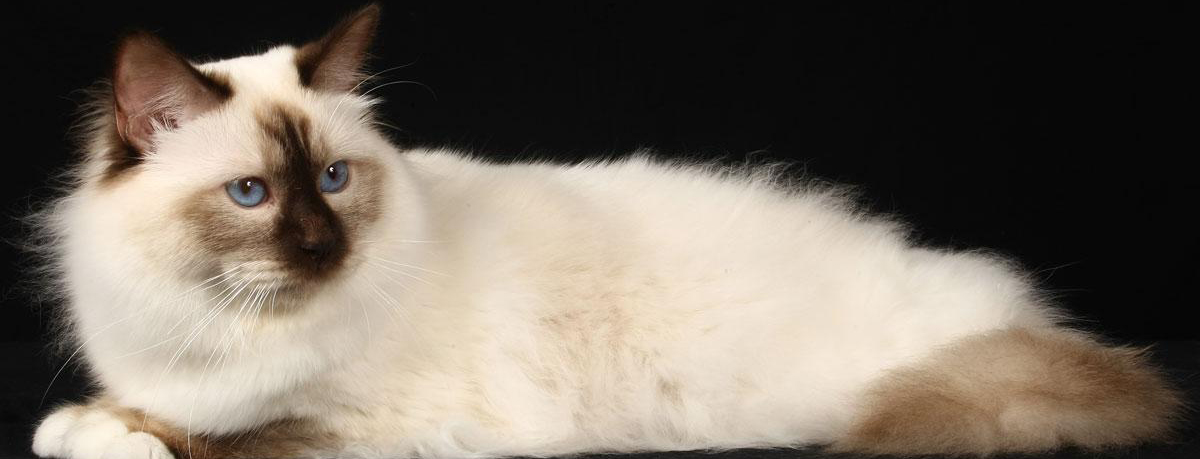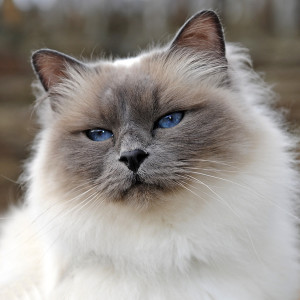Birman

Meoww!!
His piercing, sapphire-blue eyes stare deep into your soul, and his semi-long coat — ideally misted with gold — is silky to the touch.
In 5 Words
- Calm
- Affectionate
- Loving
- Adaptable
- Friendly
Snapshot
Size: Medium
Weight: 8 – 12 pounds
Origin: Myanmar
Life Span: 13-15 years
Colour: Seal, Blue, Chocolate, Lilac, Red, Cream, Tortie, Tabby

Characteristics
Learn About the Birman
There is no sure record with how the Birmans originated but there is a legend that it came from Burma where they were cared for by temple priests in Northern Burma in the Mount of Lugh. The story is often told with Auguste Pavie and Major Gordon Russell received two temple cats from the Temple of Lao-Tsun. The latter is a British officer. The place is said to be situated in the East of Lake Incaougji between Sembo and Mogaung.
The legend is credited to the writings of Mme Marcelle Adam who is a novelist and holder of Maldapour Birman Cattery and president of the Federation Feline Française. It was first published in the French Review Minerva by Dr. Francois Mery. Several wonderful tales of how the cat first appeared in France were included such as numerous cats offered as a reward for helping in defending a temple, or the cats were smuggled out of Burma through a Vanderbilt. There was also a tale involving a pair of stolen Birmans introduced by Thadde Haddisch to France. The first hints of historical Birmans were traced back to the Nice city in France to Mme Leotardi.
The Birman almost got extinct during World War II. Only a pair of cats was found to be alive in Europe after the war. They were named Orloff and Xenia de Kaabaa who belonged to Baudoin-Crevoisier. The breed was founded with this pair during postwar France. They had to be greatly outcrossed with long hair breeds such as Siamese and Persian to restore the Birman breed. During the early 1950s, they were able to produce pure Birman litters once more. In 1965, Britain recognized this breed and in 1966, so did CFA.
The first Birmans were seal-point colored. In 1959, the blue-point color was initiated with Blue Persian lines. In 1970-1980, new colors were recognized as done by English breeders. These include red-point, chocolate and tabby/lynx. A Birman has also been used to produce new breeds such as California’s Ragdoll cat.
The Birman has a different color with some parts of its body, called a point. The face, ears, tail, feet and legs are different from the rest of the body. Upon birth, they may be white and may only show the points sometime after 2 days or 2 weeks. This breed is a gorgeous long hair cat with a medium to heavy body weight. They have a silky coat that comes in an assortment of differently colored points. They also have radiant blue eyes. Birmans tend to have white gloves on every foot.
Birmans have amazing dispositions. They are playfully outgoing, self-assured, friendly and extremely inquisitive without being too demanding. They are comparable to puppies who like to follow their owners around the house. They appreciate human companionship as much as they need it. They are also fond of children. This breed is happy, trusting and adaptable.
Birmans are a healthy breed with robust immune systems. They have no health issues that you need to be mindful of. However, like most long hair cats, Birmans are subject to hair balls. To help prevent problems, a little oil with their meal can do wonders. It is recommended to feed cats with small raw bones. Those particularly found in chicken wings or necks. Doing this while they are still young will help them keep their teeth free from problems.
In contrast to Persians, the coat of a Birman cat is easier to care for. However, if you want to show your cat, you will need to give it more attention. This isn’t a hard task since the Birman is quite gentle and quiet. It’s a lot easier if your cat is okay with handling. Although maintenance is lower than most long haired cats, you should at least brush it once a week.






